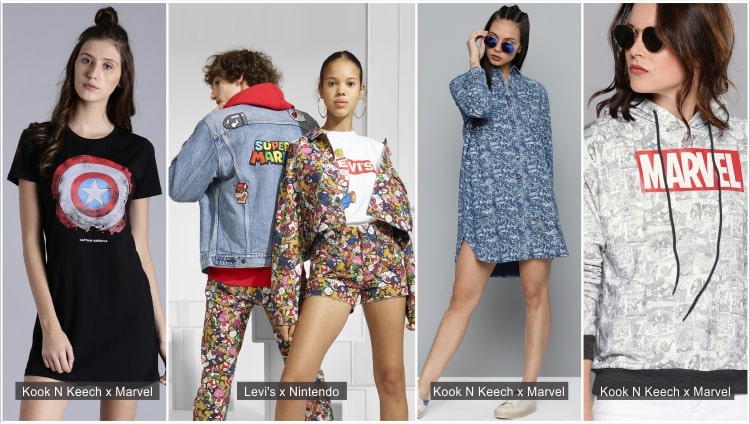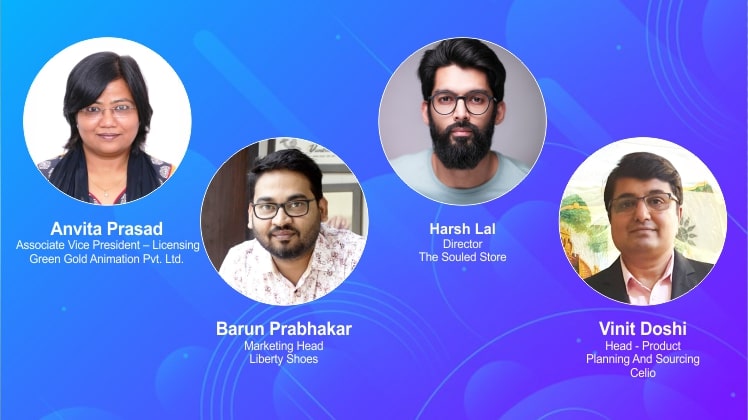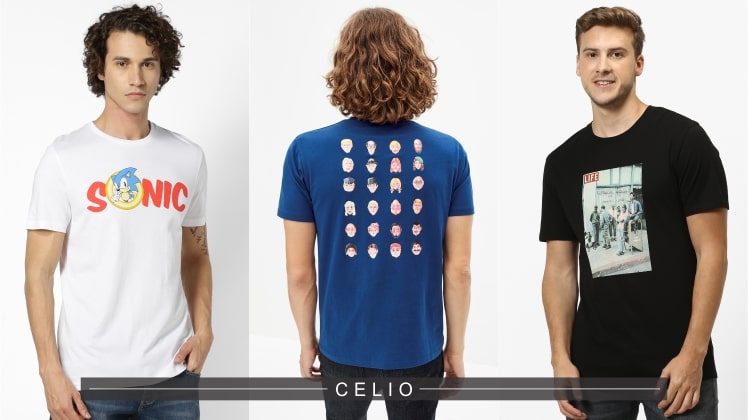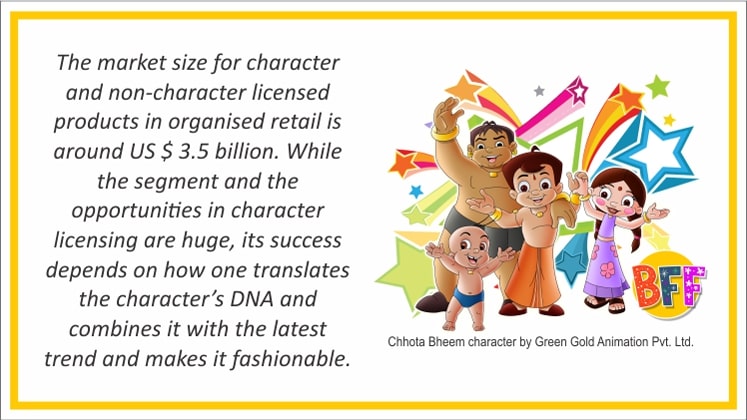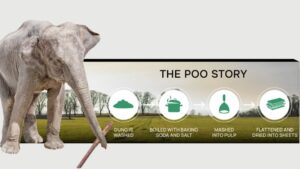Fashion is ever changing, and with an altogether new set of consumers, mostly comprising millennial youth who have grown with technology and essentially with their favourite characters from TV shows, movies, etc. Character merchandising or licensing has evolved as a new business and apparel segment has especially leveraged this to its benefit. What really is character merchandising? Well, it refers to the exploitation of a famous character to gain profits by selling merchandises with its name, face or tagline on it and it can be done by both the owner of the character or the licensee of the character.
Even though character licensing or merchandising has been in India for years, and the country has managed to create great Indian IPs while also bringing global IPs within the country, it still has a long way to go in terms of leveraging the full potential of this segment. However, the size of the domestic licensing industry is about Rs. 4,000 crore, of which 80 per cent is ruled by characters and entertainment segment. According to a recent LIMA report, in terms of market size, entertainment licensing is valued at US $ 406 million, fashion licensing at US $ 594 million, and sports licensing at US $ 30 million.
Barun Prabhakar, Marketing Head, Liberty Shoes, avers, “Character licensing is still in the nascent stage in the country as is the overall licensing industry. However, the Y-o-Y growth, especially from character licensing, has been offering the biggest numbers across the country. There has been a growth in the number of brands and manufacturers expressing their interest and launching various merchandise categories. The growth in organised retail has been the largest push for the industry. We have seen several niche portals/retailers launching outlets focused on CBM (character based merchandise). They have also been building communities which have further fuelled the growth and sales of CBM.” This demand is not only coming from urban India, but also from rural areas due to the consumption of content on mobile, growth of organised retail, new character launches, etc.
What lures retailers?
Fashion brands, retail companies, and licensees have shown tremendous growth in character-inspired merchandise and while this is only the start of a long-term trend that’s here to stay, what is really attracting them towards licensing business? With the massive young population between the age group of 16-25 years and their involvement in VOD platforms like Netflix, Amazon, Hotstar, etc., and their almost constant presence on social media and internet, it has become easy for the licensors as well as the licensees to get better business through their licenses and character merchandised products.
As Harsh Lal, Director, The Souled Store, puts it, “There has been a massive increase in demand from various Tier-2 and Tier-3 areas as well for these Western properties. I think the internet has broken a lot of barriers that were earlier there. Character licensing segment has become a lot more as compared to when The Souled Store was launched in 2013. Also, now the process has become a lot easier – both from the point of view of accessing more fan base of a character and also for companies to actually getting into the merchandising business. Besides, we also enjoy a strong relationship with our license partners who support us throughout the process and even promote us heavily on their own websites, their social media platforms and give access to their influencers, etc.”
Furthermore, selling a product which already has its own story and connect with the consumer base is no doubt more attractive to the retail owners.
“Character licensing is adding new opportunity in the fashion industry and it brings a lot of freshness and newness in the fashion category. Firstly, especially in menswear category where there is a lot of competition and almost everybody is making similar kinds of clothing since the styling remains common, the licensed merchandise brings in better sales because of its exclusive quotient. Besides, these merchandise sell on the popularity of the character itself and require no further storytelling unlike the normal collection wherein the brand needs to pitch the selling point of the product on the basis of its finish, material or sustainability factor. Even as these come into play in character merchandised products as well, but the majority of the buying decision depends on the character,” asserts Vinit Doshi, Head – Product, Planning And Sourcing, Celio.
Whose way will it be?
Character merchandising, in its organised and successful form, can be traced back to Walt Disney using its characters for secondary commercial exploitation by making merchandise after their works. And today, development surrounding character merchandising has boomed across the world with addition of an array of characters. But choosing the right partner that accelerates the business is crucial to flourishing in this segment. Explaining the licensor side of the story, Anvita Prasad, Associate Vice President – Licensing, Green Gold Animation Pvt. Ltd., a leading Indian company pioneering in creating original Indian animation content such as ‘Chhota Bheem’ series, says, “Character licensing has very bright future in India across categories and apparel being the main contributor in licensing business will always get maximum focus. Selection of appropriate licensee is multifaceted and a licensor needs to review brand value of the partner, past records of the company and its management, quality of their product, strength in distribution and manufacturing/ sourcing, and their seriousness towards the licensing association with a dedicated team for licensing segment. A brand or a manufacturer who is planning to take license should also evaluate the IP/ character on the basis of its awareness, popularity, visibility and affinity with the target audience.”
Green Gold Animation prides in having 70+ active licenses under ‘Chhota Bheem’. While the minimum tenure for product license is 1 year, most of the licenses are taken for 2-3 years since 1 year is a very short span of time to launch, distribute and establish the range/ brand in the market and at other times, it also goes up to 5-10 years.
Besides, a licensee goes for their own set of criteria before finalising on their partnership with a license firm. Even as Liberty Shoes is no longer into licensing segment, Barun Prabhakar explains, “There are few things that a brand or a manufacturer should weigh in before entering into a licensing partnership. One should always measure the popularity of the character in the markets before choosing a license. The popularity could be a spike or a regularly accepted brand. One should also look at the historical partnerships, team relationships in the market, control of bootlegged products and most importantly, support in retail growth or brand marketing activities. For The Souled Store, however, while the commercial aspect definitely is important, it is also significant for them to see that the license coming onboard is something their target audience can connect with. The Souled Store also relies heavily on its customer feedback for bringing onboard a license.”
“It is important for us to understand the licensor’s long-term goal for India – if the licensor is looking to build a brand, or is willing to invest in marketing and creating the demand for their products. In any case, one needs to do justice with the partnership they are entering into,” adds Harsh Lal.
And while that was only the first stage of it all, the partnership between a licensor and a licensee is one with close coordination and entails a lot of working together before the final product could be launched for sale. Harsh elaborates, “The licensing partners are actually very involved because eventually you are taking their property, their creation and commercialising it. It is important for the licensors to be 100 per cent sure of the designs that we do. Most licensors have a dedicated list of designs, colours and fonts that you can use. Different license firms that we have worked with, allow different amounts of freedom to play with the artwork. But according to me, it is important for the licensor to take the final call on what product should be released because essentially you are representing their brand. Besides, what is also important for the licensor is to give some sort of free hand to the licensee because a lot of time, the licensee would want to kind of experiment certain things based on what they have seen doing well, in terms of what the audience wants. I think it is very important to strike the balance between sticking to the guidelines and also having some sort of freedom to design.”
What’s working and what’s not?
According to estimates, the market size for character and non-character licensed products in organised retail is around US $ 3.5 billion. While the segment and the opportunities in character licensing is huge, its success depends on how one translates the character’s DNA and combines it with the latest trend and makes it fashionable. When it comes to reshaping the Indian licensing industry, Disney has always been a frontrunner. Disney has over 3,000 licensees globally, 150 of them in India. The over 10,000 SKUs in segments ranging from fashion, home, stationery, toys, food, health, beauty and publishing are being dished out through its strategic partnerships in the country. A leading character licensor in India, Disney’s business is aligned around four brands – Disney, Pixar, Marvel and Star Wars and offers products that cut across categories and ages—Toys, Fashion & Home, Food, Health & Beauty (FHB), Consumer Electronics, Stationery and Publishing.
Traditionally, India has been a children’s entertainment licensing market, but of late, the millennial population has also started fancying the character merchandise and surprisingly, rules a major part of the business. Anvita Prasad agrees, “Actually in India, both the segments are doing exceptionally well. Due to the overwhelming response from consumers in the last 2-3 years, India has seen birth of many online and offline stores selling character merchandise for kids as well as for adults.” The kidswear range, meanwhile, features smostly cartoon characters and not human characters, and for adult clothing range, it’s mostly a mix of cartoon characters, or human characters from TV shows, movies, etc.
While global iconic characters, which people have grown with or growing with, will always remain iconic and will have an undebatable fan base, the recent years have seen tremendous growth in popularity of Indian characters as well. Chhota Bheem being at the forefront followed by other brands such as Motu-Patlu, are some of the Indian characters that have an impressive following and retail brands too are realizing the potential of Indian characters and are investing on Indian IPs.
Harsh Lal maintains, “At The Souled Store, we have both Indian as well as global character merchandise. While global characters from Marvel and DC enjoy a bigger fan base and have created a legacy for 60-70 years, Indian TV shows, movies too are catching up. We do actually make sure that when we work with license partners, we have a healthy mix of international and national licenses. On the Indian front, we have worked with over 20 Bollywood movies, top IPL teams, stand-up comedians, top musicians, etc. We have a fair idea of working with Indian partners and western partners and I definitely see the Indian market growing at a much faster rate there is a lot of acceptance of Indian content on the internet and that definitely helps push brands around Indian content for merchandise. The aim is to make sure that no matter what property or what individual you follow, if there is an opportunity for the merchandise to be available, you will probably find it at The Souled Store.”
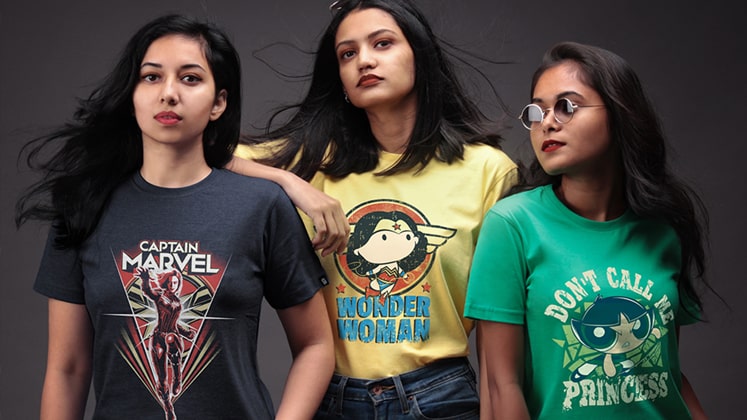
The Souled Store prides in having more than 150 licenses onboard. Meanwhile, menswear brand Celio mainly focuses on global characters for their collection including Simpsons, Star Wars, etc. and is planning on launching character merchandise with Sonic, Legends, Jiu Jitsu, Monopoly, in the next season. Others like Reebok, in partnership with Warner Bros. Consumer Products, launched its collection with television cartoon series Tom & Jerry this February. Levi’s also partnered with Nintendo to create its highly anticipated Super Mario collection which was a streetwear-inspired collection based on the brand’s style and the adventures of Mario.
How far will the segment go?
Character merchandising is categorised in three different types: fictional character merchandising, personality merchandising, and image merchandising. Fictional character merchandising includes the artistic works like that of Cinderella or Pinocchio or cinematographic works like Mickey Mouse or Batman or Donald Duck, etc. Personality merchandising includes merchandising of the person who plays the character and not the character only. For example, T-shirts that are red and gold can easily be associated to Iron Man and people buy it because of such association. Lastly, in image merchandising, the actual person and the character he plays are not differentiated. Then there is also merchandising of artistic works such as, artistic work of Leonardo Da Vinci, Mona Lisa, etc.
While it has been interesting to note that the past 2-3 years has seen the number of filing of trademark applications increasing drastically, there are few challenges facing this segment, the major one being piracy or sale of counterfeit products. Anvita Prasad shares, “Counterfeit products and piracy is a very big challenge for every licensor in India. At Green Gold, we tackle this issue head-on and on daily basis to safeguard the rights of our licensees. We have a very active anti-piracy team in house as well as many independent investigation agencies on board. We constantly scan the online and offline market places to identify such sellers and manufacturers. Online, we try to block all pirated products with the help of website owners and in offline formats, we keep raiding the manufacturers and taking legal action against them.”
In all, the licensing industry is going the right direction and is exploring new possible licensing scenarios across the country, but all this depends on how well India adapts and develops the industry in the next 4-5 years. Though the industry needs some push and support from the government on creating clarity for licensees on licensing laws and a proper licensing policy needs to be in place for the industry to flourish organically, it will be an interesting journey to look out for in the times to come.

